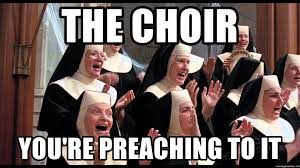Find your purpose for preaching sermons, that is.
In Edwards’, Miscellanies 40, Edwards writes:
“Without doubt, ministers are to teach men what Christ would have them to do, and to teach them who doth these things and who doth them not; that is, who are Christians and who are not.” (Kimnach, p. 22, emphasis added)
I think most of us would say that that’s our purpose for preaching, or at least one major purpose for preaching: “…to teach men what Christ would have them to do…”
It’s the second and third part of Edwards’ purpose that I feel most of us would not have on our radar for a given Sunday sermon: “…to teach them who doth these things and who doth them not; that is, who are Christians are who are not.”
Are you consciously thinking about this this week while you’re developing your sermon? What about while you’re preaching on Sundays?
Over the years I’ve said to our faith-family at Calvary Bible Church, Mount Joy, PA: “I’m on a mission to make sure there are no surprises at the judgment.” What I mean by that is I want to preach in such a way that none of my parishioners will stand before God thinking they’re a shoe-in and hear those tragic words, “Depart from me….”
I will never forget hearing Chuck Swindoll say: the longer I pastor, the more I realize that less and less of my listeners are really Christian. He said that when he was still at his Evangelical Free church in Fullerton, CA. I was a very young pastor at the time and that moved me deeply.
Somehow along the way, I’ve adopted Edwards’ purpose as my own. Along with teaching people to do the things Jesus said to do, I purpose to also teach them who does those things and who doesn’t; that is, who are Christians and who aren’t. Edwards knew there were false professors in his congregation; unfortunately so do I.
Consider adding that to your purpose for preaching so God receives glory in the church and in Christ Jesus (Ephesians 3:21).
Randal












